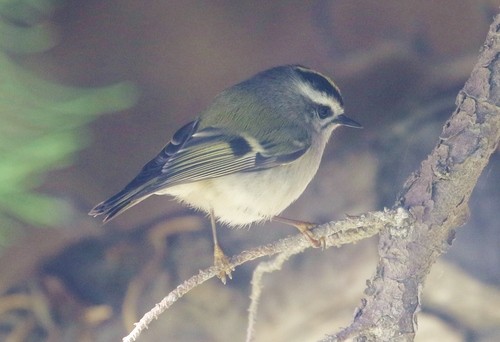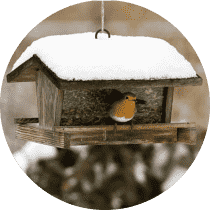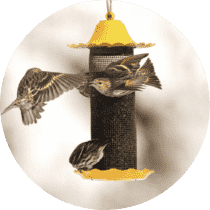Golden-crowned Kinglet
A species of Kinglets Scientific name : Regulus satrapa Genus : Kinglets
Golden-crowned Kinglet, A species of Kinglets
Botanical name: Regulus satrapa
Genus: Kinglets
Content
Description People often ask General Info
 Photo By silversea_starsong , used under CC-BY-NC-4.0 /Cropped and compressed from original
Photo By silversea_starsong , used under CC-BY-NC-4.0 /Cropped and compressed from original Description
Adults are olive-gray on the upperparts with white underparts, with thin bills and short tails. They have white wing bars, a black stripe through the eyes and a yellow crown surrounded by black. The adult male has an orange patch in the middle of the yellow crown. The juvenile is similar to the adult, but with a browner back and without the yellow crown. This is one of the smallest passerines in North America. Its length, at 8 to 11 cm (3.1 to 4.3 in), is probably the shortest of any American passerine. However, its weight, which averages around 5.9 g (0.21 oz), with a range of 4 to 7.8 g (0.14 to 0.28 oz), is marginally more on average than the American bushtit and black-tailed gnatcatcher. The golden-crowned kinglet has a wingspan of 5.5-7.1 in (14-18 cm). 
Size
9 - 10 cm
Colors
Green
Yellow
Gray
White
Life Expectancy
6.3 years
Nest Placement
Tree
Clutch Size
3 - 11 eggs
Incubation Period
1 - 2 broods
Number of Broods
15 days
Nestling Period
16 - 19 days
Feeding Habits
Golden-crowned Kinglet's diet primarily consists of small, soft-bodied arthropods, including springtails, grasshoppers, and various larvae. They glean food from foliage in warmer seasons and add seeds during winter, adapting foraging strategies like hovering and hawking to capture prey.
Habitat
Golden-crowned Kinglet can predominantly be found in boreal or montane coniferous forests, thriving up to elevations of approximately 11,000 feet. These birds favor environments ranging from deciduous and mixed woodlands to wooded bogs, conifer plantations, and hemlock groves. During migratory periods, golden-crowned Kinglet utilizes a variety of habitats, including old fields and urban green spaces such as parks and cemeteries. In winter, golden-crowned Kinglet adapts to a diverse array of settings, including both coniferous and deciduous areas, bottomland hardwoods, swamps, and even cityscapes.
Nest Behavior
Golden-crowned Kinglet engages in nest-building 4-6 days, sourcing materials nearby the nest tree. Following construction, egg-laying and parental care ensue, with both parents involved in the nurturing of the young.
Nest Characteristics
Golden-crowned Kinglet’s nest is typically found up to 60 feet high in conifers, close to the trunk, sheltered by needles. It’s a deep, cup-shaped structure made of mosses, spiderweb, plant material, insect cocoons, lichens, and bark, lined with finer materials plus deer hair and feathers. The nest is roughly 3 inches in height and width, with a 1.5-inch inner cup.
Dite type
Insectivorous
People often ask
General Info
Feeding Habits
Bird food type
Bird Feeder Type

Small Hopper

Small Tube Feeder
Sounds
Call
Recording location: United States
Song
Recording location: United States
Song
Recording location: United States
Behavior
Golden-crowned Kinglet demonstrate notable territorial and mating behaviors. Males fiercely protect their territory from intruders while flaunting their vibrant crown patches and emitting sharp calls. These birds are monogamous, typically raising two sequential broods each season. The female exclusively incubates the eggs, reliant on the male for sustenance. Golden-crowned Kinglet retain this territorial instinct against various other species during nesting, ensuring the safety of their young until fledging. Interestingly, outside breeding periods, golden-crowned Kinglet exhibit sociability, joining mixed-species flocks, illustrating a contrast in their solitary nesting demeanor versus their communal non-breeding activities.
Distribution Area
The golden-crowned kinglet is a widespread migratory bird throughout North America. Its breeding habitat is coniferous forests across Canada, the northeastern and western United States, Mexico and Central America. It migrates to the United States in the non-breeding season. Some birds are permanent residents in coastal regions and in the southern parts of their range. Northern birds remain further north in winter than the ruby-crowned kinglet. 
Species Status
Not globally threatened.
Scientific Classification
Phylum
Chordates Class
Birds Order
Perching birds Family
Goldcrests and kinglets Genus
Kinglets Species
Golden-crowned Kinglet